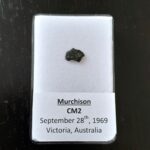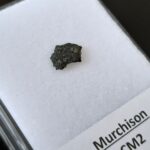- You cannot add "Aguas Zarcas meteorite. CM2 type, amino acids and water content" to the cart because the product is out of stock.
Murchison meteorite. CM2 with pre-solar grains
Characteristics
| Weight | 0,052 grams |
|---|
$95
Out of stock




Description
The Murchison Meteorite fell on 28 September 1969 in Australia. It was observed by the neighbors that saw the fireball and heard the shock wave. It is considered to be the most studied meteorite in history together with the Allende meteorite. It fell after the Apollo 11 had gone to the moon, which provided analitical laboratories to study extraterrestrial rocks.
It is a carbonaceous chondrite type CM2. In it, scientists have found a water content of 12%, alcohols, hydrocarbons and dozens of amino-acids, which seems to be the type of meteorite that established the basis for the origin of life on Earth. Individual grains of pre solar dust have also been found. They floated in our galaxy for billions of years and became part of the solar nebula, where the asteroids formed. Also trace elements have been studied. Some of them have shown different isotopic compositions to the ones that of our Solar System could have done. It has been suggested that hundreds or thousands of stars could have contributed to the specific composition of Murchison, being those minerals 2 billion years older than the Sun, which makes them between 5.000.000.000 and 7.000.000.000 years old. That is roughly, half of the time since time exist (Big Bang).
It is one of the most sought after meteorites and cannot be missing in any collection. Most specimens are now in museums or in private collections and are barely offered for sale anymore.
Certificate of authenticity included. IMCA 5591.
Shipping is combined in all my listings – if you win multiple items, only one shipping cost is paid.
Do not miss this opportunity!

















